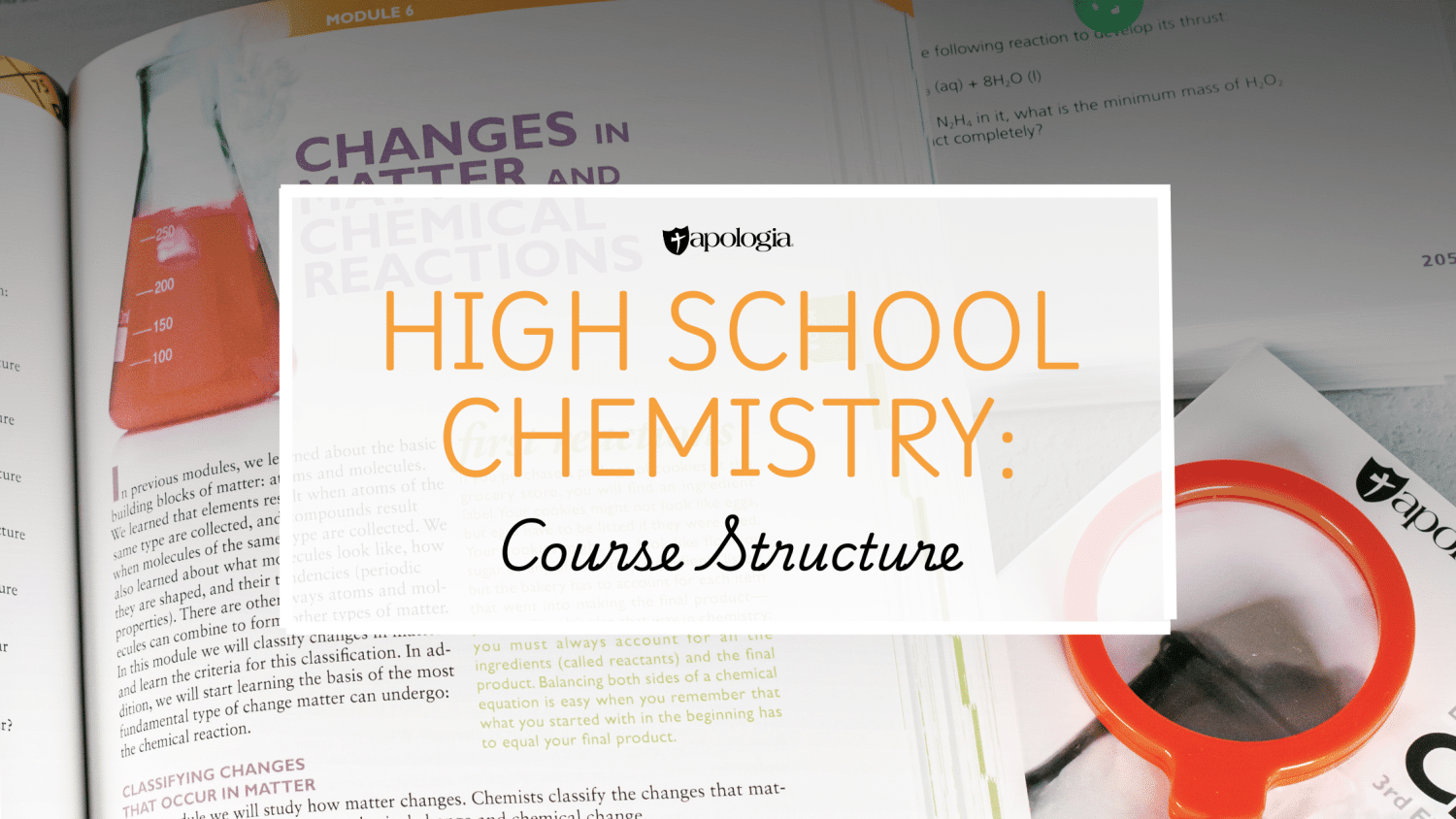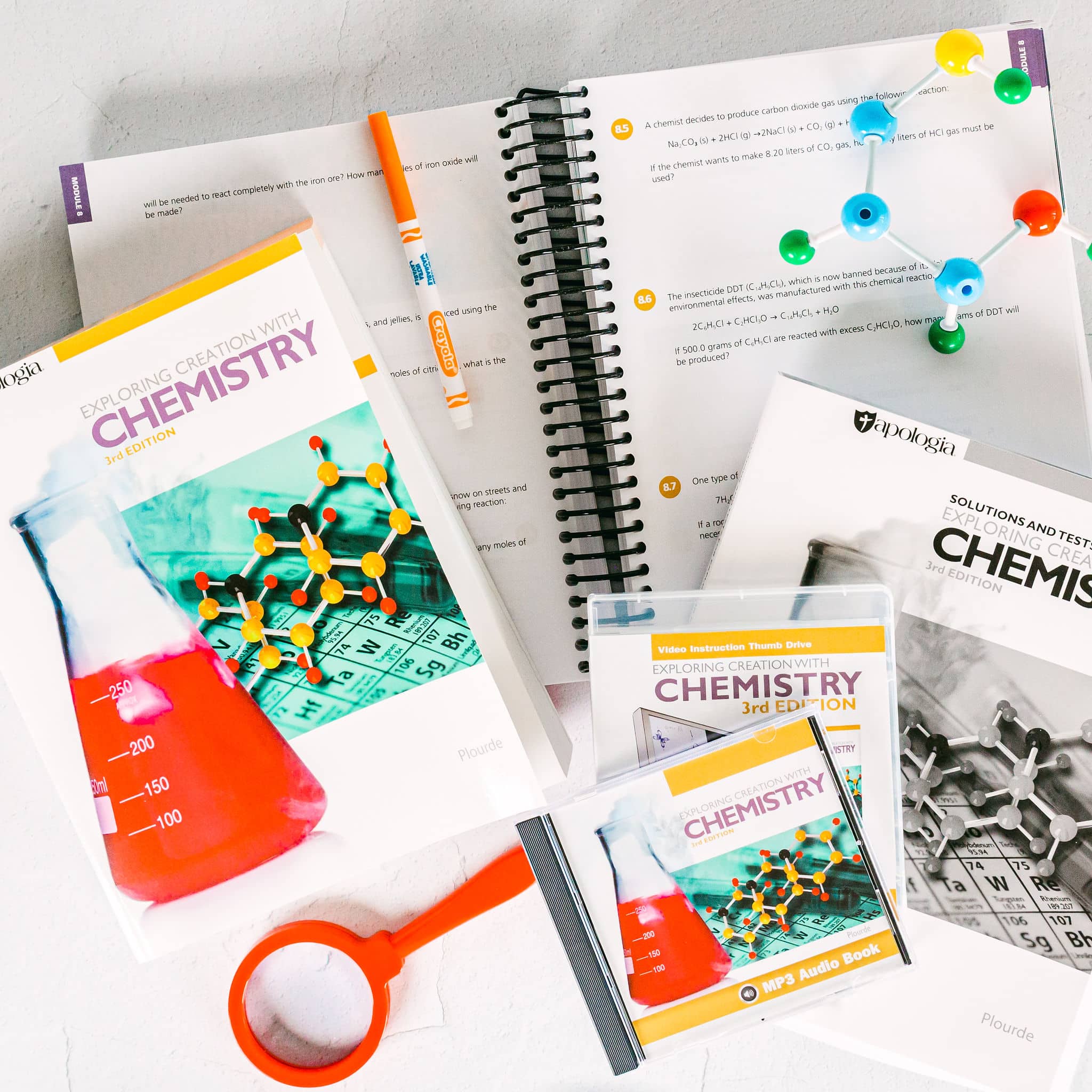
High School Chemistry: Course Structure
Apologia makes high school chemistry for homeschooling students that much simpler. It’s suitable for all learning styles, including auditory (audiobook), reading/writing learners (textbook/snotebook), hands-on (experiments), and visual (video lessons and experiments) learners.
Covering the fundamentals of chemistry in 16 modules (approxiately 2 weeks per module), students will gain a deeper understanding of the subject, using both practical and theoretical applications. Students will also have the opportunity to review questions and practice problems at the end of each module.
Watch this sample video lesson of Module 1.
Module 1: Measurements, Units & Scientific Method
As part of this high school chemistry curriculum, students will learn about units and measurements, as well as the steps involved in the scientific method and data interpretation. The module will look at:
- Determining if air has mass/if it takes up space
- Units of measurement, the metric system, and converting between units
- Making measurements, measuring temperature, and derived units
- Significant figures in mathematical problems
- The nature of a scientific law
Module 2: Atoms & Molecules
In learning to understand that atoms are the basic building blocks of matter, students will take a closer look at atoms and molecules. This module includes:
- Early attempts to understand matter
- The law of mass conservation
- Elements and compounds
- The law of multiple proportions
- Dalton’s atomic theory
- Understanding molecules in compounds
- Abbreviating and classifying compounds
- Ionic and covalent matter
Module 3: Atomic Structure
Students will dive deeper into the structure of an atom, considering its fundamental structure in this module.
- Understanding its subatomic particles and their locations
- Electrical charge and atomic structure
- Determining the number of protons and electrons in an atom
- Determining the number of neutrons in an atom
- Isotopes and nuclear bombs
- The nature of light
- The electromagnetic spectrum
- The relationship between frequency and energy
- How the eye detects color
- The Bohr model of the atom
- The quantum mechanical model of the atom
- Abbreviated electron configurations
Module 4: Molecular Structure
Students will learn more about the molecular structure in module 4, developing their understanding of how these structures influence a substance’s physical and chemical properties. As part of the module, they will discuss:
- Electron configurations and the periodic table
- Lewis structures for ionic compounds
- Exceptions in ionic compounds and how to handle them
- Ionization energy and periodic properties
- Electronegativity and atomic radius
- Lewis structures of covalent compounds
- Application of Lewis structures
Module 5: Polyatomic Ions & Molecular Geometry
To understand ionic nomenclature and bonding, students will consider polyatomic ions, memorizing common ones to name and form ionic compounds. As part of the module, students will study:
- The VSEPR theory in molecular geometry
- Nonpolar covalent and polar covalent bonds
- Nonpolar covalent and polar covalent molecules
- The practical consequences of whether or not a molecule is polar covalent
- Comparing the solubility of ionic compounds
Check out this flip-through of the Exploring Creation with Chemistry, 3rd Ed. course textbook.
Module 6: Changes in Matter & Chemical Reactions
In Module 6, students will take a further look at how substances change and what this means for their atomic structure. They will uncover:
- Changes that occur in matter
- Chemical and physical changes
- Phase changes
- The kinetic theory of matter
- The relation between the speed and temperature of molecules
- Density and phase changes in water
- Chemical reactions and equations
- Whether or not a chemical equation is balanced
- Balancing chemical equations
Module 7: Describing Chemical Reactions
The curriculum teaches students how to describe chemical reactions based on the types they can come across. The module dives further into:
- The three basic types of chemical reactions
- Decomposition reactions
- Formation reactions
- Combustion reactions
- Combustion of metals
- Complete combustion reactions
- Incomplete combustion reactions
- Atomic and molecular mass
- The mole concept & using it in chemical equations
- Measuring the width of a molecule
Module 8: Stoichiometry
Stoichiometry helps students better understand the quantitative relationship between reactants and products within a chemical reaction. The module will cover:
- Mole relationships in chemical equations
- Limiting reactants and excess components
- Determining which reactant is the limiting reactant
- Fully analyzing chemical equations
- Relating products to reactants in chemical equations
- Using chemical equations when the limiting reactant is identified
- Volume relationships for gases in chemical equations
- Using stoichiometry to determine chemical formulas
- Empirical and molecular formulas
Module 9: Acid-Base Chemistry
As part of Module 9, students will explore acid-base chemistry, considering how substances either donate (acids) or accept (bases) hydrogen ions. Students will take a look at:
- Common household examples of acids and bases
- The chemical definitions of acids and bases
- The behavior of ionic compounds in aqueous solutions
- Identifying acids and bases in chemical reactions
- Recognizing acids and bases from their chemical formulas
- Predicting the reactions that occur between acids and bases
- The reactions between acids and covalent bases
- Molarity
- The dilution equation
- The importance of concentration in chemistry
- Using concentration in stoichiometry
- Acid-base titrations
Module 10: The Chemistry of Solutions
Module 10 looks at the fundamental concepts of solutions, an ideal segway from the topic of acids and bases. Students will learn:
- How solutes dissolve in solvents
- Solubility
- Determining the effect of temperature on the solubility of solid solutes
- Determining the effect of temperature on the solubility of a gas
- Energy changes that occur when making a solution
- Investigating a solute that releases heat when dissolved
- Applying stoichiometry to solutions
- Molatility
- Freezing-point depression
- Measuring freezing-point depression and boiling-point elevation
Check out this flip-through of the Exploring Creation with Chemistry, 3rd Ed. Student Notebook.
Module 11: The Gas Phase
The gas phase is one of the fundamental states of matter, characterized by particles that move freely, lack a definite shape or volume, and fill the container they are in. Module 11 will therefore explore:
- The definition of pressure
- Boyle’s law
- Charles’s law
- The combined gas law
- Ideal gases
- Dalton’s law of partial pressures
- Vapor pressure
- An alternative statement of Dalton’s law
- The ideal gas law
- Using the ideal gas law in stoichiometry
Module 12: Energy, Heat & Temperature
To help further explain molecular motion, energy, heat, and temperature are introduced in Module 12, teaching students the following topics:
- Energy and heat
- The first law of thermodynamics
- Units for measuring heat and energy
- Thermometer calibration and confirmation of boiling and freezing temperatures of water
- The calorie unit
- Measuring heat
- Calorimetry
- Measuring the specific heat of a metal
Module 13: Thermodynamics
The topic of thermodynamics in Module 13 covers energy changes and transfers in chemical and physical processes. The module explores:
- Enthalpy
- Using bond energies
- Hess’s Law
- Applying enthalpy to stoichiometry
- Energy diagrams
- The second law of thermodynamics
- The proper application of the second law of thermodynamics
- Gibbs free energy
Module 14: Kinetics
Kinetics is the study of reaction rates and the factors that influence them. As part of the module, students will learn:
- Reaction kinetics
- Factors that affect the kinetics of a chemical reaction
- The rate equation
- Using experiments to determine the details of the rate equation
- Catalysts and reaction rate
- The effect of a catalyst on the decomposition of hydrogen peroxide
Module 15: Chemical Equilibrium
In equilibrium, forward and reverse reactions happen at the same rate, so the concentrations of reactants and products remain constant. As part of Module 15, students will learn:
- The definition of chemical equilibrium
- Demonstration of equilibrium
- The equilibrium constant
- Using the equilibrium constant to predict the progress of a reaction
- Le Chatelier’s Principle & in the context of temperature and pressure
- Acid-base equilibria
- The pH scale
- Acid rain
Check out this flip-through of the Exploring Creation with Chemistry, 3rd Ed. Solutions Manual and Tests.
Module 16: Reduction-Oxidation Reactions
This module addresses the transfer of electrons. Redox reactions are essentials for understanding electrochemistry, chemical reactions, and the activity series of metals. The module looks at:
- Oxidation numbers and determining them
- Oxidation and reduction
- Recognizing reduction-oxidation reactions
- Important characteristics of reduction-oxidation reactions
- How batteries work
- Corrosion
Find Out More About Apologia’s Homeschool Chemistry Curriculum
Following a biblical worldview, you can ready your students for the college-level sciences with our homeschool chemistry curriculum for high schoolers.
Want to know more? Explore the details of our live classes or discover our self-paced courses.




